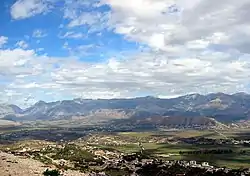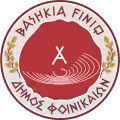Finiq
Φοινίκη (Foiniki) | |
|---|---|
 The highlands of Delvinë and the hill of Finiq, ancient Phoinike, in the center of the picture behind the plains. | |
 Flag  Emblem | |
.svg.png.webp) Finiq | |
| Coordinates: 39°54′N 20°3′E / 39.900°N 20.050°E | |
| Country | |
| County | Vlorë |
| Government | |
| • Mayor | Romeo Cakuli (MEGA) |
| Area | |
| • Municipality | 444.28 km2 (171.54 sq mi) |
| Population (2011) | |
| • Municipality | 10,529 |
| • Municipality density | 24/km2 (61/sq mi) |
| • Municipal unit | 1,333 |
| Time zone | UTC+1 (CET) |
| • Summer (DST) | UTC+2 (CEST) |
| Postal Code | 9716 |
| Area Code | (0)895 |
| Website | bfiniq |
Finiq (Albanian: Finiq or Finiqi, Greek: Φοινίκη, romanized: Foiniki) is a settlement, considered town or village, and municipality in Vlorë County, in southern Albania located 8 km from the Ionian Sea and 20 km north of the Greek border. It was formed at the 2015 local government reform by the merger of the former communes Aliko, Dhivër, Livadhja, Mesopotam, and Finiq itself. It is inhabited by ethnic Greeks and is one of two municipalities in Albania in which Greeks form a majority, alongside Dropull. The seat of the municipality is the village Dermish.[1] The total population is 10,529 (2011 census),[2] in a total area of 444.28 km2.[3]
The population of the former municipality at the 2011 census was 1,333;[2] according to the civil offices, which count all citizens including those who live abroad, was 6,780 (2011 estimate).[4]
Name
The ancient name of the Greek toponym (Greek: Φοινίκη) was not preserved through literary revival. As such the modern settlement retained in the Ottoman register of 1431 its name Finiki.[5]
History
In antiquity, Phoenice was the political center of the Epirot Greek tribe of the Chaonians. Early Byzantine architecture (4th-7th century) is evident in the settlement in particular that of the three aisled basilica type.[6]
The settlement retained its ancient name and is mentioned in an Ottoman record of 1431 as Finiki.[7] According to the Chronicle of Gjirokaster the first years of Ottoman rule (15th century) were peaceful but after the Fall of Constantinople (1453) Finiki (that time known as Phinikoupolis) was destroyed by the Muslims.[8] At the end of the 16th century Finiki witnessed a drastic population increase and became one of the largest settlements in the area with 359 households (compared to contemporary Gjirokastër with 302 and Delvine with only 204 taxable households).[9]
At 1870 a secondary Greek language school was already operating in Finiq.[10]
Demographics
Ottoman registries
In the Defter of the Sanjak of Delvinë from 1431-1432, 4 villages in the area of Vurgu are recorded: Finiki (Finiqi), Vurgo, Jeromi and Krajna (Kranéja) each with very few inhabitants. Among these villages, the Ottoman register of 1520 attests typical Albanian names are attested inscribed such as: Gjin, Reçi,Leka,Gjon, Dorza, Meksh Nika and Deda.[11]
The Ottoman defter of 1582 for the Sanjak of Delvina provides records for the village of Finiq. A significant portion of the anthroponyms recorded in the register belonged to the Albanian onomastic sphere, including personal names such as Bos, Dedë, Dodë, Gjergj, Gjin, Gjokë, Gjon, Lalë, Lekë, Muzhak, and others. However, more ambiguous or general Christian anthroponyms that were historically used by both Albanian and non-Albanian groups are also attested. In Finiq, a quarter of the population recorded bore purely Albanian anthroponyms. These figures do not take into account kinship ties shared between individuals bearing typical Albanian anthroponymy and those bearing more ambiguous names, and also do not include those bearing names that can be etymologically explained through Albanian (e.g., Buzmiri, Bala, Bardhi, Burriqi, Buzuku, Çobani, Dera, Iriqi, Kuka,Marsi, Mara, Macja, Poçi, Plaku, Uk, Ylli). As such the ethnic Albanian element must have represented a larger proportion. [12]
19th century
Athanasios Psalidas (1767–1829), counselor of Ali Pasha of Ioannina noted that the town was inhabited by an ethnic Greek community.[13]
Modern demographics
The 2015 Albanian civil registry, which counts all citizens including those who live abroad, recorded a much higher municipal population of 39,055.[4] The municipal unit of Finiq comprises the villages Finiq, Buronjë (Mavropull), Çlirim, Vrion, Karahaxhë and Bregas (Vromero).[14]
The town of Finiq and all the villages of the municipality are exclusively inhabited by Greeks, except the village of Çlirim, which is mixed.[15][16]
According to the ministry of foreign affairs of Albania, the Greek population of the commune of Finiq amounts to 5531, making it the Greeks a majority.[17] The inhabitants use the Greek language towards local government authorities and the toponyms and street addresses are written in both Albanian and Greek in official documents.[18]
See also
References
- ↑ "Law nr. 115/2014" (PDF) (in Albanian). p. 6376. Retrieved 25 February 2022.
- 1 2 "Population and housing census - Vlorë 2011" (PDF). INSTAT. Retrieved 2019-09-25.
- ↑ "Correspondence table LAU – NUTS 2016, EU-28 and EFTA / available Candidate Countries" (XLS). Eurostat. Retrieved 2019-09-25.
- 1 2 "Vlora's communes". Retrieved 13 January 2016.
- ↑ Kyriazis, Doris (2019). "Διατοπικότητα και διαχρονικότητα των νεοελληνικών γλωσσικών ιδιωμάτων της νότιας Αλβανίας" (PDF). Modern Greek Dialects and Linguistic Theory. 8th International Conference of Modern Greek Dialects and Linguistic Theory (in Greek). Gjirokastër: University of Patras. p. 124. ISSN 1792-3743.
Προσπαθώντας να ανακτήσουμε τα «εδάφη» της μνήμης μας, οφείλουμε στα αυθαιρετήματα να αντιτάξουμε επιχειρήματα. Στα σπλάχνα του τόπου μας διασώθηκαν λέξεις και τοπωνύμια μπροστά στα οποία καταρρέουν η αυθαιρεσία και η «αμνησία». «...οι κάτοικοι της περιοχής δεν απώλεσαν ποτέ τη μνήμη του ένδοξου παρελθόντος της ελληνικής πόλης. Η επιβίωση της αρχαίας ονομασίας, που φαίνεται ότι έχει μεταδοθεί αδιάλειπτα στον οικισμό που εξακολουθούσε να υπάρχει στους πρόποδες του λόφου μέχρι και τις μέρες μας, αποτελούσε ένα επιπλέον εχέγγυο μνήμης...» 26 . Τα λόγια αυτά ανήκουν σε ιταλό συνάδελφο και αφορούν την αρχαία Φοινίκη της Ηπείρου, αλλά και το σημερινό Φοινίκι, στο λόφο του οποίου υπάρχει το Κάστρο των Ελλήνων, όπως το ονόμασε ο ντόπιος γεροβοσκός απαντώντας σε ερώτημα του Pouqueville στα 1807. Οικισμός Finiki καταγράφεται και σε οθωμανικό κατάστιχο του 1431, που αφορά την περιοχή αυτή (Inalcık 1987: 137), άρα η ονομασία Φοινίκι δεν είναι λόγια αναβίωση του αρχαίου οικωνυμίου
- ↑ Giakoumis, 2002, p. 123
- ↑ Kyriazis, Doris (2019). "Διατοπικότητα και διαχρονικότητα των νεοελληνικών γλωσσικών ιδιωμάτων της νότιας Αλβανίας". Proceedings of the International Conference Series of Modern Greek Dialects and Linguistic Theory. 8: 122. doi:10.26220/mgdlt.v8i1.3010. Retrieved 24 August 2020.
- ↑ Giakoumis, 2002, p. 71
- ↑ Giakoumis, 2002, p. 54
- ↑ Koltsida, Athina (2008). Η Εκπαίδευση στη Βόρειο Ήπειρο κατά την Ύστερη Περίοδο της Οθωμανικής Αυτοκρατορίας [Education in Northern Epirus during the Latter Ottoman Period] (pdf) (in Greek). Aristotle University of Thessaloniki. p. 187. Retrieved 16 December 2012. (PhD Thesis)
- ↑ Demiraj, Shaban (2008). "La situation ethnique-linguistique des habitants de Dropulli et de Vurgu au cours des siecles". Studia Albanica. Academy of Sciences of Albania. 1: 77–91. ISSN 0585-5047.
Les noms propres de formes typiques albanaises sont rencontrés aussi dans le Defter du Sandjak de Delvinë de 1431-1432 sur Vurg, appelé ainsi par le mot du grec moderne vurkos "pays bas, marais". Dans ce registre-là ne sont enregistrés que quatre villages Finiki (Finiqi), Vurgo, Jeromi et Krajna (Kranéja) avec très peu d'habitants21. Parmi ces villages Finiqi évoque le nom de l'ancienne cité des Chaons, Phoeniks, fondée vers le Ve s. avant l'ère moderne. Concernant ces villages aussi, dans le registre ottoman ci-dessus mentionné sont inscrits des noms albanais typiques tels que : Gjin Reçi, Gjin Panariti, Gjin Zagorino, Gjin Krali (Frali), Leka Gjini (2 fois), Kozha Gjini, Gjin Vija, Zhupa Gjin, Gjini Spiri, Gjin Andrea, Kont Gjin Andrea, Gjon Dorza, Gjon Zhurmo, Meksh Gjoni, Polimer Gjoni, mais aussi Jani Jagop, Jani Katani, Jani Kosta, Jani Bogdani, Luka Jani, Jani Ispatari, Nika Jani (Finiq), Gjin Ilia, Gjin Pelegri, Gjin Kasnesi, Gjon Pelegri, Dhimo Gjini, Gjon Martini, Martin Gjoni, Deda Gjoni (Krane)22. Mais, selon Shkurti23, dans la zone de Vurgu, en 1927, ont été recensés 25 villages : Çukë, Pal, Aliko, Çaush, Tremul, Kasëmallajbej, Kaliveshush, Jermë, Halo, Kalivepasha, Krané, Ymerefend, Finiq, Vrion, Memushbej, Hajdëragas, Qenurjo, Karalibej, Vromero, Karahaxh, Mavropull, Metoq e Gjashtë, Rahullë, Shijan, Muçopolit, Mullamus qui, en 1927, comptaient en tout 3262 habitants. Donc, la majorité de ces villages ont dû être fondés après le recensement ottoman du XVe sc.
- ↑ Gjergji, Andromaqi (1987). "Disa të dhëna per popullsinë e zones së delvinës në shek. XVI". Kultura Popullore (1): 195–7.
Shumë studiutes janë të mendimit se në repertorin e emrave të shekujve XV-XVI figurojnë një varg emrash, përkatësia etnike shqiptare e të cilëve nuk mund të vihet në dyshim. Të tillë janë: Gjergj, Gjon, Gjinaku, Gjokë, Dodë, Dedë, Lekë, Mile, Nikë, Prend, Pal, Martin, Mëhill, Muzhak, Laskë, Lalë, Laloç, Lilë, Bos, Pjetër, Dukë, Shigjon, Tanush, Skura etj. Nga një llogaritje e përafërt që arrita të bëj për disa fshatra, po të numërojmë personat që kanë si emër ose si mbiemër femrat e lartpërmendur, kemi këto të dhëna: në Finiq mbajnë të tillë emra afro një e katërta e banorëve; në Nivicë më tepër se tri të katërtat; në Kakodhiq, Dragopezde, Ufnë e Izmenicë një e treta; një e dyta në Vagalat; më tepër sfe një e treta në Luvinë; tri të pestat në Sopik; pothuaj gjysma në Zishtë e në Pendelejmon; pothuaj katër të pfestat në Peoë; një e treta në Lefterohor; tri të katërtat në Likurs etj. Natyrisht, këtyre përqindjeve do të duhej t'u shtonim vëllezërit ose bijtë që janë regjistruar pranë tyre, рог që kanë të tjerë femra, lidhja e afrisë të të cilëve diiket mjaft qartë në regjistër. Gjithashtu, do të duhej t'u shtonim edhe personat që mbajnë emra kuptimorë shqip, si p.sh.: Buzmiri, Bala, Bardhi, Burriqi, Buzuku, Çobani, Dera, Iriqi, Kuka, Marsi, Mara, Macja, Poçi, Plaku, Uk, Ylli e ndonjë tjetër, që i ndeshim në fshatra të ndryshme.
- ↑ Giakoumis, Konstantinos (2016). "Self-identifications by Himarriots, 16th to 19th Centuries". Erytheia. 37: 218.
- ↑ Greece – Albania Neighbourhood Programme Archived March 27, 2012, at the Wayback Machine
- ↑ Kallivretakis, Leonidas (1995). "Η ελληνική κοινότητα της Αλβανίας υπό το πρίσμα της ιστορικής γεωγραφίας και δημογραφίας [The Greek Community of Albania in terms of historical geography and demography." In Nikolakopoulos, Ilias, Kouloubis Theodoros A. & Thanos M. Veremis (eds). Ο Ελληνισμός της Αλβανίας [The Greeks of Albania]. University of Athens. p. 52.; p. 51. "ΑΧ Αλβανοί Ορθόδοξοι Χριστιανοί, ΤΣ Τσάμηδες"; p.54. "FINIQΙ ΦΟΙΝΙΚΙ 1953 Ε".
- ↑ Badlands-Borderland: A History of Southern Albania/Northern Epirus by T.J. Winnifrith,ISBN 0-7156-3201-9,2003,Page 69,"... 16. Greek-speaking children in modern Finiq ..."
- ↑ https://rm.coe.int/16806befc5 (page 98)
- ↑ https://rm.coe.int/16806befc5 p. 60
Sources
- Konstantinos., Giakoumis (2002). "The monasteries of Jorgucat and Vanishte in Dropull and of Spelaio in Lunxheri as monuments and institutions during the Ottoman period in Albania (16th-19th centuries)". University of Birmingham. Retrieved 20 May 2018.
{{cite journal}}: Cite journal requires|journal=(help)


